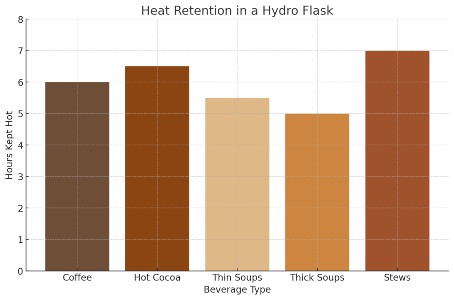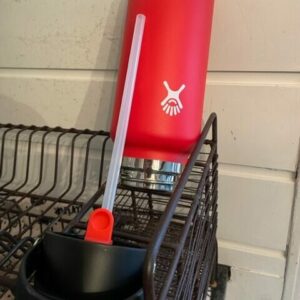As a busy guy who loves whipping up big batches of hearty soups and stews in my slow cooker, having an easy way to transport delicious home-cooked meals is a must. But can the popular Hydro Flask stainless steel bottles safely transport steaming spoonfuls of chunky beef chili or creamy potato soup without making a mess? After a month of road testing, I’m spilling the savory details.
Whether sipping split pea soup at your desk or slurping ramen noodles trailside, Hydro Flask has cracked the code for portable soup nirvana thanks to smart insulation technology that keeps things steamy six times longer than flimsy food jars. But the perks go way beyond temperature alone.
Transport hot, delicious homemade soups or stews effortlessly in Hydro Flask bottles thanks to commercial-grade stainless steel insulation that retains ideal 140-160° sipping temperatures for up to 6 hours. Just be sure to leave ample air space when filling, fully hand wash interiors after each use, and reheat soups in separate containers before transferring piping portions into Hydro Flasks
Key Takeaways
- Hydro Flask’s durable stainless steel construction and commercial-grade insulation can safely store piping hot soups for up to 6 hours while retaining flavor.
- Thorough cleaning after each use prevents residue or smells from impacting the taste of future beverages stored in the Hydro Flask.
- Leave ample airspace when filling the Hydro Flask with soup to prevent dangerous pressurization and allow for expansion as heat rises.
- Broth-based and heartier soups with proteins, fiber, and modest fats store best over time compared to thin, watery fruit gazpacho.
- The large opening of the Hydro Flask Wide Mouth bottle makes loading spoonfuls of chunky soup ingredients much easier without excessive cooling.
- Don’t overfill or actively freeze soup inside Hydro Flasks to avoid seal integrity issues or overflow dangers upon opening.
Can Hydro Flask Bottles Safely Store Hot Soups and Stews?
As a lover of pungent pho broths and fiery tortilla stews, finding a food-safe vessel hearty enough to withstand boiling batches without warping, staining, or imparting metallic flavors has always been tough. But Hydro Flask’s durable stainless steel build changed the soup commute game for good.
The medical-grade 18/8 steel construction stands up to repeated soap scrubbing and prolonged simmering temperatures without degrading or leaching icky chemicals into precious homemade stocks. An ergonomic powder coating also provides a non-slip grip, rivaling roomy ceramic bowls.
When paired with their Flex Cap lid, specially designed to create a leakproof seal on wide mouth openings, you’ve got a rugged soup jug ready for transport anywhere while keeping every nourishing morsel protected. No more emergency changes of clothes thanks to thermos failures!
How Long Will Hydro Flask Keep My Soups and Stews Hot?
Here’s a simple graph showing the approximate length of time that a Hydro Flask bottle will keep various liquids, including soups and stews, hot on average.

Imagine how frustrating it is to pack your favorite pho or lentil soup into a travel mug before work only to take your first glorious sip 2 hours later, realizing barely lukewarm contents instead of gently steaming.
Thankfully, Hydro Flask insulation crushes that heating disappointment by keeping soup between 140 and 160 degrees for up to 6 full hours in most cases. That’s over four times longer than cheap aluminum or plastic options to retain enjoyable slurping heat.
The key is Hydro Flask’s TempShield proprietary insulation, which involves double vacuum-sealed stainless steel walls, completely blocking temperature transfer and heat escaping through condensation. Food-grade 18/8 steel also facilitates fantastic conductivity, rapidly equalizing cooler outer layers as you incrementally sip down scalding internals over a long lunch break.
Just don’t expect 12 hours like some mugs boast—really protein-rich soups with dairy components or oils see the most dramatic cooling and thickening around the 5–6 hour mark in the largest Hydro Flask models. But smaller 12- to 20-ounce portable soup sizes stay steamy for 80–90% of an entire workday when needed.
Does Storing Soups or Stews in a Hydro Flask Affect Future Beverage Taste?
One common concern soup lovers have is whether intensely flavored ingredients like onions, garlic, or carrots could leach into plain water later stored in the same container despite washing. Especially potent spices like curry also worry people about tenaciously transferring flavors later on.
Thankfully, stainless steel’s nonporous properties prevent microscopic odor absorption when properly caring for your Hydro Flask, unlike plastic, which traps smells more easily. Its intact steel walls create a protective barrier, locking out external residue penetration when cleaned correctly.
However, failing to promptly wash soup remains or letting leftovers dry into a sticky film can allow future drinks or shake mixes to pick up hints of onion, pickle brine, or red pepper flakes through physical contact rather than odor retention in the steel itself.
So as long as you thoroughly hand scrub the bottle’s interior walls using a bottle brush after each spicy coconut curry or zesty garden veggie soup stint, your Hydro Flask easily returns to neutral, allowing delicious plain water, coffee, or protein shake flavor later on. I find that there is no need to own designated soup-only bottles!
Can Storing Soups or Stews Lead to Stains or Odors in Hydro Flasks?
Two inevitable issues with hauling around flavorful homemade soups loaded with oils, spices, and plant matter are stubborn stains visually marring your pristine stainless interior and notorious aromas like curry or kimchi breeding inside and refusing to lift.
Thankfully, Hydro Flask’s durable exterior powder coating and smooth steel inside see far less stubborn staining from ingredients like turmeric, saffron, or carrot purees, which visually stain cheaper metals yellow and orange gradually. Nonporous steel also resists trapping vinegar notes or aggressively spicy chili residue, which plastic permanently captures over time.
But you still need to thoroughly hand wash and air dry your soup flask completely upside down after each savory use to fully remove the microscopic matter and moisture responsible for staining or stench issues in the long term. Over time, microscopic scratches from metal utensils can also increase aroma ghosts.
So while steel itself doesn’t breed smells or stains alone, enough particles clinging inside dents, straw tops, or scratched walls slowly discolor and funk up your flask. Sticking to gentle cleaning and plastic utensils prevents leftover soup from ruining future water-refreshing attempts.
What Are the Best Practices for Filling a Hydro Flask with Soup or Stew?
Successfully hauling heaping portions of your famous chicken and dumplings or creamy potato leek soup requires perfecting your Hydro Flask packing process. Here are my pro tips for soup transport success:
• Leave ample airspace! Liquids expand as heat rises so avoid cramming to the absolute brim, which risks dangerous pressurization or violent eruptions from sudden opening.
• Allow a few minutes for the hot contents to fully interact with the inner steel, absorbing some conduction that settles things down before capping for maximum hold times.
• Use wide-mouth models, allowing better ingredient loading without clogging chunks. Or puree extras smooth for standard opening.
• Consider smaller 12–20 oz. sizes for portable soup versus giant 64 oz. growler models that are difficult to sip from directly.
Follow these filling best practices, and your favorite hearty soups magically transform into a portable meal surviving hours outside the kitchen. Just beware of the messy perils of overfilling to the absolute top!
How to Clean Your Hydro Flask After Soups or Stews?

Failing to promptly wash your Hydro Flask of leftover broths, noodle fragments, and oily residues after soup transport means disappointing your next lemon ginger ale refreshment attempt with unnecessary savory hints.
Here’s a simple 5-step routine to thoroughly purge soup remains from your faithful flask after every hearty meal:
• Rinse immediately with hot water to lift sediment before drying or hardening.
• Fully disassemble caps and pieces to access stuck bits.
• Scrub the interior with a non-abrasive bottle brush, mild scentless soap, and hot water.
• Visually inspect for any lingering oil sheens, suggesting further washing is needed.
• Air dry completely upside down to prevent secondary smells from moisture-hiding spots.
Repeat this soup cleaning ritual, and your Hydro Flask easily transitions back to neutral each time without retaining vague broth funk or spicy curry fumes, sabotaging future water enjoyment no matter how aggressively flavored the soup contents may have been before.
Get more details:
What Types of Soups Store Best in Hydro Flask Bottles?
With hundreds of cultural soup possibilities, from Vietnamese pho to Portuguese caldo verde, how do you know what homemade mixes will retain optimal texture, temperature, and flavor in your Hydro Flask mobile container?
In general, broth-based wonton, chicken with noodles, and tomato basil all store beautifully, staying steaming hot and vibrant for 4+ hours. Heartier stews like beef barley, split peas, or butternut bisque also hold up well. Cream bases may gradually separate with oils beading on top over long durations.
On the flip side, avoid packing thin, clear broths lacking protein or fiber, which over-concentrate into salty sludge after hours above heat. Watery fruit gazpachos also dilute rapidly. Soups dominated by straight oils see the largest temperature and texture drops as well.
When exploring soup takeout possibilities, scan the recipe for higher-fiber starches, amino acid proteins, and modest fats that retain richness best over extended insulating hold times. Your taste buds and Hydro Flask will thank you!
How Does Hydro Flask’s Wide Mouth Benefit Soup and Stew Storage?
Slurping delicious soup from traditional narrow-mouthed vessels means awkward angling to capture hearty ingredients in smaller batches or excessive cooling, splashing out wide steam plumes with each tip back.
Thankfully, Hydro Flask’s signature extra-wide Flex Cap mouth opening, measuring nearly 2” across, was specially designed for safely packing wider liquid contents like soup chunks or smoothies using handy funnels.
You’ll enjoy way easier access, allowing you to heap spoonfuls of slippery noodles, soft veggies, or meat bites without needing to tediously wait for cooldowns. The same wide openings also create ample filling room for chunky chowders.
For maximum wide-mouth perks, opt for the 64-ounce “growler”-sized Hydro Flasks, which provide a spacious loading zone for forkfuls of your fabulous freezable leftover turkey chili going mobile.
Can You Freeze Soups or Stews Inside a Hydro Flask?
What’s better than piping hot soup conveniently stashed inside your Hydro Flask all day? Having freezer-ready homemade options already pre-portioned for fast reheating whenever fierce hunger strikes!
Many people wonder if storing fully prepared stews, stocks, and chowders frozen inside the Hydro Flask itself could simplify meal prep. Unfortunately, freezing liquids directly is not recommended.
While the insulation does slow temperature flux slightly, Hydro Flask doesn’t recommend actively freezing contents, which poses seal integrity risks and overflow dangers when removing lids.
Instead, portion hearty soup-night creations into reusable plastic tubs or bags first before transferring thawed servings into your flask as needed for heated commuting. The freezer holds things safer long-term.
Pro tip:
Toss your Hydro Flask in the freezer itself for 10–15 minutes before filling it with simmering soup to precool it before putting it in freezer containers! The chilled walls will cool down your soups and stew far quicker than room-temperature surfaces.
How to Prevent Leaks from a Soup-Filled Hydro Flask?
Nothing elicits panic faster than glancing down mid-commute to suddenly notice dripping golden chicken broth staining your work bag thanks to an unknown Hydro Flask seal failure.
Thankfully, leakage issues are extremely rare in properly functioning Hydro Flasks bottles thanks to durable food-grade silicone gaskets and snugly nesting lid openings.
However, avoiding spill catastrophes starts with not overfilling beyond maximum capacity, which exerts excess outward pressure. Also, let overheated contents rest for a few minutes, allowing bubbles to settle before sealing lids to contain things.
Check for any cracks or dents affecting gasket seal integrity before pouring in hot liquids. And don’t forget to orient flip straw tops in the upright closed position when stowing bags to help prevent violent shaken openings mid-transit.
If leaks do occur, contact Hydro Flask warranty support to evaluate replacement gasket seals, caps, or straw mechanisms likely needing attention before your next public soup commute!
Do Certain Soup or stew Ingredients Impact Insulation Properties?
Given the endless soup recipe possibilities blending various oils, acids, spices, and plant matter, it’s normal to wonder if certain ingredients mess with your Hydro Flask’s carefully engineered temperature regulation powers.
Thankfully, the stainless steel composition and commercial-grade vacuum sealing withstand exposure to pretty much any edible acids or oils without material degradation interfering with heat retention compared to plastics or lesser metals.
However, more aggressive turmeric, mustard or cumin spice components could gradually stain the durable powder-colored exterior coatings, which don’t affect actual insulation functioning but appear unsightly over time.
Within reason, keep enjoying all your favorite seasonal soup creations and exotic spice blends without worrying about the impact of Hydro Flask’s boiling broth-holding capabilities! Just be extra diligent in cleaning stained layers.
What Features and Accessories Make Hydro Flask More Soup and Stew-Friendly?
One bright spot improving Hydro Flask’s soup swigging functionality is the booming accessory niche catering specifically to liquid meal transport needs, including:
• Funneled lids simplify pour-overs of chunky bits without mess or burn risks
• Specialty-wide bottle brushes perfectly sized for quick bottle cleaning
• Super easy-to-use bottle-cleaning tablets for deep bottle-cleaning
• Soft bottle slings for easy carrying during extended transport
So browse around for handy soup-centric add-ons that elevate your Hydro Flask into the ultimate mobile soup-sipping system!
Conclusion
Transporting hearty homemade soups to stay hot and delicious for hours while on the go used to seem impossible until Hydro Flask’s innovative insulation solutions. Their specially engineered stainless steel bottles now provide the perfect vessel for enjoying your favorite chicken noodle, tomato basil bisque, or spicy chili con carne recipes hours after leaving the kitchen.
The non-leaching, durable construction stands up to boiling broths and chunky ingredients without impacting taste or temperature. So whether enjoying a steaming cup of ramen at your desk or chugging savory stew on the trails, Hydro Flask bottles handily replace thermoses and bowls, keeping each nourishing bite insulated to perfection. Just be sure to fully wash after daily soup stints before your next water refill!
FAQ’s
Q: What are the risks of microwaving soup inside my Hydro Flask?
A: You should NEVER put any metallic items in a microwave. Hydro Flask does not recommend placing their bottles directly inside microwave ovens under any circumstances due to potential seal, lid, and insulation damage risks. Reheat soup in separate microwave-safe containers first before transferring.
Q: How do I get spice and flavor residue out after storing soups?
A: Wash immediately after finishing the soup to remove sediment residue before drying and hardening occur. Use a thin bottle brush with mild scent-free soap and very hot rinse water to fully purge spice oils and dissolve stuck-on food bits after each savory soup or stew storage session.
Q: What causes leaks when storing hot soup in Hydro Flask bottles?
A: Overfilling bottles beyond their maximum capacity can lead to excess outward pressure that could cause your Hydro Flask lid to get stuck, or that the lid and gasket seals can’t contain, leading to leaks, especially when shaken or tipped upside down. Let extremely hot contents rest a few minutes before sealing lids to help prevent dangerous pressurization. Also, inspect for any cracks or dents affecting the lid alignment.
Q: Can I put dairy-based creamy soups into my Hydro Flask?
A: Yes, dairy-laden creamy soups like chowders can be stored in Hydro Flasks but they may see more significant texture and separation issues after extending durations exceeding 4+ hours. The combination of heat and time tends to break down the emulsification leading to oil beading but it is still generally safe if consumed promptly.

About Me
I’m Paul Burkhardt, an expert in water and water treatment since 2006 with in-depth experience not only in treating water but also in helping to provide people with healthier, high-quality drinking water.
I’ve helped thousands of people with their drinking water questions, including what kind of water bottle might be best for them and their lifestyle.
If you’d like more information about me, please check out the links below or read more here:

